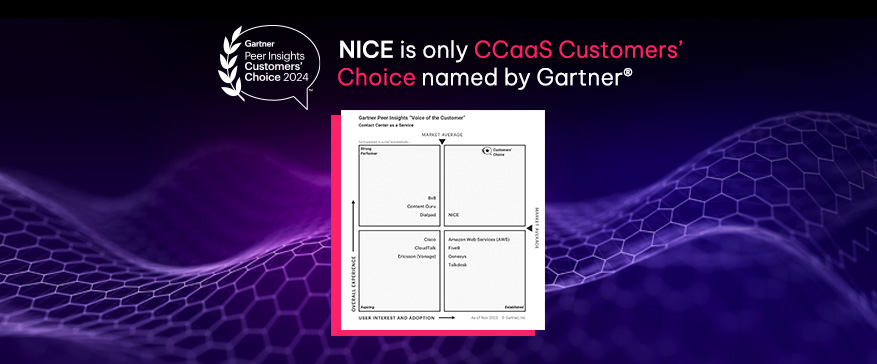CXone Mpower Orchestrator
The Limitations of Legacy Contact Center Systems
Legacy contact center systems can hinder an organization’s ability to provide the service required to stay competitive. These outdated systems often lack the advanced features and functionality needed to support modern customer expectations. Some of the limitations of legacy contact center systems include:- Inability to Handle Multiple Communication Channels: Legacy systems often struggle to support digital channels such as social media, email, and chat, leading to a disjointed customer experience. This limitation prevents customers from engaging through their preferred channels, reducing overall satisfaction.
- Limited Scalability: As call volumes increase, legacy systems can become overwhelmed, resulting in dropped calls and poor voice quality. This inability to scale efficiently can lead to significant service disruptions and lost business opportunities.
- Lack of Real-Time Analytics: Legacy systems often lack the ability to provide real-time analytics and reporting, making it difficult for organizations to make data-driven decisions. Without real-time insights, businesses cannot effectively monitor performance or identify areas for improvement.
- Inability to Integrate with Other Business Systems: Legacy systems often lack the ability to integrate with other business systems, leading to data silos and inefficiencies. This fragmentation hinders the flow of information across the organization, impacting overall productivity and customer service.
- High Maintenance Costs: Maintaining legacy systems can be costly, with high expenses associated with hardware and software upgrades. These ongoing costs can strain IT budgets and divert resources from more strategic initiatives.
Signs Your Legacy Contact Center is Outdated
If your legacy contact center system is exhibiting any of the following signs, it may be time to consider modernizing:- Missed Calls and Wasted Time: If your system is unable to handle increased call volume, leading to missed calls and wasted time, it’s a clear indication that your infrastructure is struggling to keep up with demand.
- Poor Customer Satisfaction: Long wait times, unhelpful agents, and inconsistent service are signs that your customers are experiencing poor service. This can lead to decreased customer satisfaction and loyalty.
- High Maintenance Costs: If your system is becoming increasingly costly to maintain, with high costs associated with hardware and software upgrades, it’s a sign that your legacy infrastructure is no longer cost-effective.
- Limited Scalability: An inability to handle increased call volume, resulting in dropped calls and poor voice quality, indicates that your system lacks the scalability needed to support growth.
- Lack of Real-Time Analytics: If your system lacks the ability to provide real-time analytics and reporting, making it difficult for you to make data-driven decisions, it’s a sign that your contact center is not equipped to meet modern business needs.
Core Capabilities of Modern Contact Center Platforms
Cloud-Native, Elastic ArchitectureModern contact center platforms are built in the cloud with elastic infrastructure that grows with demand, alleviating the high cost and high risk associated with maintaining outdated legacy systems. These legacy call center and legacy contact center solutions often require significant IT resources and involve exorbitant licensing fees, making modernization a financially sound decision. This eliminates the need for physical hardware or costly upgrades. Businesses can launch new features, spin up service hubs in new regions, or support thousands of concurrent users without worrying about capacity constraints. Cloud delivery also ensures automatic updates and quicker access to new features and security patches.Integrated Omnichannel SupportLegacy systems often only support voice or require bolt-on tools to manage email or chat. In contrast, modern platforms natively support voice, SMS, email, live chat, social media, WhatsApp, and in-app messaging—providing a seamless experience across all channels. Customers can start an inquiry on one channel and finish it on another, without repeating themselves or losing the thread of the conversation. Outdated systems that are no longer supported by the manufacturer pose a high risk of lost data and security breaches, making the transition to modern solutions imperative.Built-In Artificial Intelligence and AutomationAI capabilities are integrated throughout the platform to handle routine tasks, speed up agent decision-making, and ensure faster resolutions. These include virtual agents that answer common questions, predictive routing that matches customers with the best agent, and real-time assistance tools that recommend the next best action during live interactions. This intelligent automation reduces handle time, increases containment rates, and allows teams to focus on high-value conversations. Integrating modern AI solutions with outdated systems can lead to compatibility issues, highlighting the need for system-agnostic alternatives that enhance efficiency without requiring a complete overhaul.Unified Agent DesktopModern platforms consolidate all communication channels, customer history, and support tools into a single interface. Agents no longer need to switch between systems or dig through records to find answers. A unified desktop displays real-time context, case history, knowledge base access, and performance metrics—allowing agents to respond faster and with greater accuracy.Real-Time and Historical ReportingOne of the biggest limitations of legacy systems is a lack of insight into agent productivity, customer behavior, and channel efficiency. Modern systems provide customizable dashboards and analytics tools that track KPIs in real time and over time. Supervisors can analyze call volume trends, digital deflection rates, customer sentiment scores, and more—helping identify performance gaps and prioritize improvements.Open API Framework for Seamless IntegrationsModern platforms are built with flexibility in mind. They integrate easily with CRM platforms like Salesforce, Dynamics, or Zendesk, as well as workforce management systems, payment gateways, marketing automation platforms, and enterprise data lakes. APIs make it easy to build new workflows, share data across departments, and align the contact center with the broader enterprise ecosystem.Enterprise-Grade Uptime and Global ResilienceCloud platforms use distributed architecture to offer high availability, load balancing, and geographic failover. This ensures your service is always online, even in the event of local outages or high-volume spikes. Built-in disaster recovery and regional redundancy mean your business remains operational and compliant, no matter what happens.Continuous Improvement Through Agile UpdatesIn legacy systems, new features often require major version updates, downtime, or custom development. Modern platforms deliver innovation continuously. From AI improvements to compliance updates, new functionality is automatically rolled out with minimal disruption. This keeps your platform current and your contact center ahead of the curve.Choosing the Right Contact Center Solutions
When choosing a contact center solution, there are several factors to consider. Some of the key considerations include:- Scalability: Ensure the solution can handle increased call volume and growth. A scalable platform will support your business as it expands, preventing service disruptions and maintaining high-quality customer interactions.
- Integration: The solution should integrate seamlessly with other business systems, such as CRM and ERP. This integration ensures a unified flow of information, enhancing efficiency and enabling a holistic view of customer interactions.
- Real-Time Analytics: Look for a solution that provides real-time analytics and reporting. Access to real-time data allows you to monitor performance, make informed decisions, and quickly address any issues that arise.
- Multi-Channel Support: The solution should support multiple communication channels, such as social media, email, and chat. This capability ensures a seamless customer experience across all touchpoints, meeting modern customer expectations.
- Cost: Consider the costs associated with the solution, including hardware, software, and maintenance. Evaluate the total cost of ownership to ensure the solution is cost-effective and aligns with your budget.
Key Benefits
Dramatic Cost Savings Over TimeLegacy systems come with heavy maintenance fees, infrastructure overhead, and upgrade costs. They require dedicated IT teams to maintain servers and patch software, leading to high costs. Additionally, these outdated systems pose a high risk due to vulnerabilities and compliance issues. Modern platforms operate on predictable subscription pricing, reduce reliance on IT, and lower total cost of ownership through automation, elasticity, and reduced hardware requirements.Agility to Respond to Change QuicklyModern platforms are configurable, not coded. This allows business users and operations leaders to quickly launch new channels, update call flows, change routing logic, and implement customer journey enhancements without relying on months-long development cycles. In a competitive market, this speed is a strategic advantage.Significant Improvements in Customer SatisfactionWhen customers can choose their preferred channel, avoid repeating themselves, and receive personalized, timely help, satisfaction increases. Modern platforms reduce frustration by eliminating silos, providing fast routing, and using AI to assist both customers and agents. Organizations replacing legacy systems often see measurable improvements in CSAT and NPS within the first year.Higher Agent Retention and PerformanceAgents working on outdated systems face more friction, slower processes, and a lack of visibility. Modern platforms remove these barriers. With access to streamlined workflows, real-time insights, and smarter tools, agents are more productive and less frustrated. Better tools contribute directly to higher engagement, reduced turnover, and improved performance outcomes.Stronger Data Governance and ComplianceRegulatory compliance is increasingly complex. Modern platforms simplify this by providing centralized control over data access, audit trails, encryption protocols, and retention policies. You can enforce GDPR or HIPAA rules globally while still supporting region-specific needs like data localization or consent handling. Legacy systems that are no longer supported by the manufacturer can lead to lost data and security breaches, making modern solutions essential.Support for Remote and Hybrid Workforce ModelsLegacy systems were built for static, office-based teams. Today’s cloud platforms enable full functionality for remote and hybrid agents with browser-based tools, secure access controls, and real-time visibility for supervisors. This flexibility is now essential for hiring, scalability, and business continuity.Challenges with Legacy Call Center SystemsOutdated legacy call center systems hinder efficiency and growth. These legacy contact center solutions struggle to meet the increasing expectations of today's customers, affecting service quality. Transitioning to advanced solutions, such as AI-augmented contact centers, is necessary to overcome these limitations and enhance operational performance.Dealing with Outdated SystemsContact centers using outdated systems face significant challenges. These systems, originally designed for different purposes, often have compatibility issues with modern AI solutions. A system-agnostic alternative can enhance the efficiency of outdated systems without requiring a complete overhaul.Avoiding the Pitfalls of Legacy Contact Center Systems
When modernizing a legacy contact center system, there are several pitfalls to avoid. Some of the key pitfalls include:- Underestimating the Complexity of the Modernization Effort: Modernizing a legacy system can be a complex and time-consuming process. It’s essential to plan thoroughly and allocate sufficient resources to manage the transition effectively.
- Failing to Consider the Needs of All Stakeholders: It’s essential to consider the needs of all stakeholders, including customers, agents, and IT staff. Engaging stakeholders early in the process ensures that the new system meets everyone’s requirements and gains broad support.
- Not Providing Adequate Training: Providing adequate training to agents and IT staff is crucial for a smooth transition. Comprehensive training programs ensure that everyone is comfortable with the new system and can use it effectively from day one.
- Not Testing the New System Thoroughly: Thorough testing is essential to ensure that the new system meets all requirements and is free from defects. Rigorous testing helps identify and address any issues before the system goes live, minimizing disruptions.
- Not Having a Plan for Data Migration: A well-defined plan for data migration is essential to ensure that all customer data is transferred to the new system. Proper data migration prevents data loss and ensures continuity of service.










